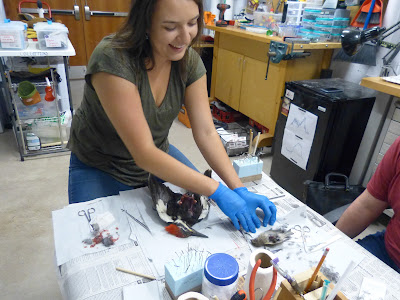Trials of Taxidermy Week
We had a rough start to "taxidermy week." As I worked alongside my dedicated volunteer who had been assigned to a house sparrow, sighs and the occasional grumble filled the air just as readily as the delicate feathers which began floating above our work station. I felt bad--honestly--for both the bird and Al, but I couldn't help but tease him just a bit while I tried to soothe his frustrations as the sparrow's remains fell apart before his eyes. "Well at least it isn't completely unsalvageable!"
 |
| Contrary to popular belief, work IS fun--at least when you work at the Museum! |
Each year, interns at the Museum have the unique opportunity to learn the art of taxidermy from collections staff. It's often their first time, and the process can be as entertaining as it is educational. Al is perhaps one of the first to partake in such fun as an unpaid volunteer. After weeks of herbarium work, both he and I finally agreed that it was time to move away from plants. So, the first of now two designated taxidermy training sessions of the summer has begun at the Museum.
Al felt eager to start. I watched him struggle to contain his excitement as I opened up the vintage red Marlboro cooler that's been repurposed into an animal thawing apparatus. A salvaged pileated woodpecker and house sparrow were bagged up inside, and we were quick to release them.
In my experience, songbirds are a great subject to start with when learning the process of taxidermy. They're small, so they don't take up too much time. Most species have relatively similar features so it's easy to transfer skills before moving on to larger birds or mammals with more difficult anatomy to process. And importantly, songbirds are most numerous as far as our salvaged animal deposits go.
Apparently, not all songbirds in our freezer become easy taxidermy subjects. We started out simple and slowly--I prepared the woodpecker and used its size to allow me to demonstrate each step before Al mimicked my procedure. After the first incisions were made and we began to both dissect our birds, Al commented about how feathers had started to come loose from the skin. I reassured him that that was natural as some feather loss was expected--we would camouflage it later on. Then more began to accumulate on the paper towel "place mat." For just a split second I worried that I might have been rushing him through his work, but to my fault attributed the seemingly minimal damage to lack of experience in the practice.
 |
| After the first handful of steps during our taxidermy training, a number of house sparrow feathers accumulated around Al's work station. |
Finally, in frustration, Al then asked me if skin separation was normal too. At that point I realized I had neglected the poor collections assistant, and put my woodpecker on hold to remedy the matter. The incredibly thin skin of the sparrow had begun to come off in small pieces as Al did his best to pry skin and feather from internal tissue. Taking a moment to work on the sparrow myself, I too realized that the bird effectively fell apart as we moved along. After apologizing to my volunteer, I conceded to Al that what had happened was not normal, and that the bird likely suffered from poor preservation in the freezer.
We've learned a lot during the first few days of taxidermy week--I truly gained as much as Al did. While we still have some steps to go before our finished product, I'm feeling quite satisfied with our work already. Al has turned his failed taxidermy mount of the house sparrow into preserved wings and soon a preserved skull, and we'll both be finishing the woodpecker as a full body mount for future display. Just as with any other difficult project at the Museum, there's always room to fix our work and learn something from the experience.
 |
| All was certainly not lost. We salvaged both wings and the sparrow's skull to be used for teaching opportunities. |



